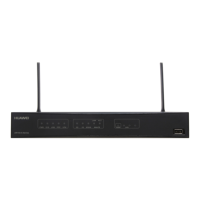On the AR150/200, DDNS policies can only be bound to Layer 3 interfaces and VLANIF
interfaces.
----End
4.5.5 Checking the Configuration
After configuring a DDNS client, you can view the DDNS client configuration.
Procedure
l Run the display ddns policy policy-name command to view DDNS policy information.
l Run the display ddns interface interface-type interface-number command to view DDNS
policy information on the interface.
----End
Example
# Run the display ddns policy command to view information about the DDNS policy
JackPolicy.
<Huawei> display ddns policy JackPolicy
Policy name : JackPolicy
Policy interval time : 3600
Policy URL : oray://Jack:Jack2010@phddnsdev.oray.net
Policy bind count : 1
===== interface Ethernet1/0/0 ======
Statuses: START
Refresh: enable
# Run the display ddns interface command to view the DDNS policy information on VLANIF
100.
<Huawei> display ddns interface Vlanif 100
===== Policy JackPolicy =======
URL: oray://Jack:Jack2010@phddnsdev.oray.net
Statuses: START
Refresh: enable
4.6 Maintaining DNS
This section describes how to maintain DNS.
4.6.1 Deleting Dynamic DNS Entries of DNS Clients
This section describes how to delete dynamic DNS entries of DNS clients.
Procedure
Step 1 Run the reset dns dynamic-host command to delete dynamic DNS entries of DNS clients.
Dynamic DNS entries cannot be restored after being deleted. Exercise caution when you run the
command.
----End
Huawei AR150&200 Series Enterprise Routers
Configuration Guide - IP Service 4 DNS Configuration
Issue 02 (2012-03-30) Huawei Proprietary and Confidential
Copyright © Huawei Technologies Co., Ltd.
93

